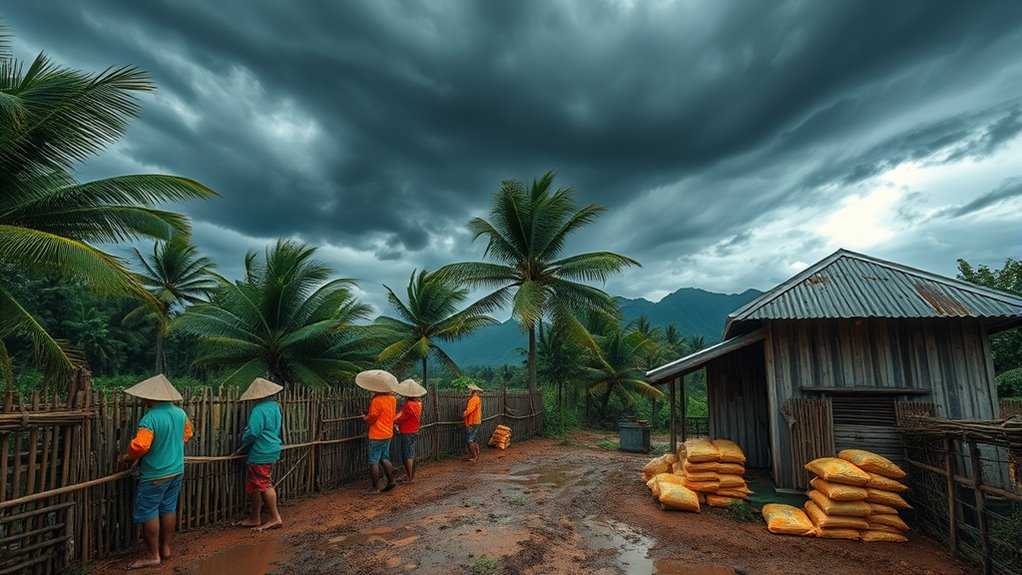To prepare for typhoons in Southeast Asia, you should create a clear evacuation plan, assemble an emergency kit, and strengthen your home against strong winds. Stay informed by monitoring weather updates and follow official warnings promptly. Secure outdoor objects and ensure drainage systems are clear to prevent flooding. Practice evacuation drills regularly to stay familiar with safety procedures. Keep calm and act swiftly during emergencies—you’ll discover more essential tips to stay safe if you continue exploring.
Key Takeaways
- Develop and practice comprehensive evacuation plans, including routes, shelters, and designated meeting points.
- Assemble an emergency kit with water, non-perishables, flashlight, radio, medications, and important documents.
- Reinforce home structures, secure outdoor objects, and clear drainage systems to minimize damage.
- Stay informed through reliable weather updates and follow official evacuation and safety advisories.
- Maintain calm, utilize essential oils if desired, and prepare in advance to reduce stress and ensure swift action.

When a typhoon approaches, being prepared can make all the difference in ensuring your safety and minimizing damage. You need to have clear evacuation plans in place so that everyone in your household knows exactly what to do and where to go. This means identifying the safest routes out of your area, knowing the locations of nearby shelters, and having a designated meeting point if you get separated. Practice these plans regularly so that they become second nature, especially under stressful conditions. Having a well-thought-out evacuation plan ensures you won’t waste precious time figuring out what to do when the storm is imminent, and it helps reduce chaos during an emergency.
Having a clear evacuation plan reduces chaos and saves time during a typhoon emergency.
Equally important is assembling an emergency kit that’s ready to go at a moment’s notice. Your kit should include essential supplies such as bottled water, non-perishable food, a flashlight with extra batteries, a first aid kit, and necessary medications. Include important documents like identification, insurance papers, and any vital contact information. Don’t forget basic hygiene items, a battery-powered radio to stay updated on weather alerts, and some cash in case ATMs or banks are inaccessible. Keeping these items in a waterproof container and storing them in an easily accessible place ensures you won’t waste time gathering supplies when seconds count. An emergency kit not only provides comfort but can also be lifesaving during a typhoon, especially if you need to stay indoors for an extended period or if power and communication lines go down.
Preparing your home is equally critical. Reinforce windows with storm shutters or plywood, secure loose outdoor objects that could become projectiles, and check your roof for weak spots. Trim trees and shrubs that could fall onto your house, and ensure your drainage systems are clear to prevent flooding. Being proactive about home preparations minimizes the risk of damage and keeps you and your loved ones safer during the storm. Additionally, understanding the importance of essential oils for disaster preparedness can help you stay calm and alleviate stress during emergencies.
Stay informed by monitoring weather updates from reliable sources, and heed warnings from local authorities. Follow their advice, especially when they advise evacuation or other safety measures. By having a detailed plan, an emergency kit ready, and a prepared home, you considerably improve your chances of weathering the storm with minimal harm. Remember, the key to surviving a typhoon is preparation—think ahead, stay alert, and act swiftly.
Frequently Asked Questions
How Do Typhoons Form Over Southeast Asia?
You might wonder how typhoons form over Southeast Asia. It all starts with typhoon genesis, where warm ocean waters trigger oceanic convection, fueling the storm. When moist air rises and condenses, it releases energy, causing the storm to grow and organize. As this process continues, the system intensifies into a powerful typhoon, drawing energy from the warm ocean and creating the destructive storms you see in the region.
What Are the Early Warning Signs of an Approaching Typhoon?
You’ll notice cloud patterns thickening and swirling, signaling a storm’s approach. Wind shifts become more noticeable, changing direction unexpectedly or strengthening. These signs act as early warnings, alerting you to an impending typhoon. Pay attention to darkening skies, increasing wind speeds, and changing weather patterns. Recognizing these signs early helps you prepare and stay safe, turning chaos into calm with timely action.
How Can Tourism Be Affected During Typhoon Season?
During typhoon season, your tourism plans can be disrupted considerably. Seasonal tourism declines as travelers cancel or postpone trips, affecting local economies. You should stay informed about weather updates and follow emergency preparedness guidelines to stay safe. Resorts and attractions might close temporarily, and transportation services could be limited. By prioritizing safety and staying flexible, you can better navigate the challenges of typhoon season and protect yourself and others.
Are There Specific Myths or Misconceptions About Typhoons?
Some superstitions and myths swirl around typhoons, leading you to believe they’re purely cursed or caused by misdeeds. You might think myths mean you should avoid certain actions or places during storms, but these cultural misconceptions miss the mark. Typhoons are natural weather phenomena, shaped by climate patterns, not curses or karma. Understanding the science helps you stay safe and separate superstition from reality during storm season.
What Are Long-Term Environmental Impacts of Frequent Typhoons?
Frequent typhoons can cause long-term environmental impacts like ecosystem disruption, which you might notice in damaged forests and coral reefs. Climate change intensifies these effects by increasing storm frequency and severity. As a result, you could see altered wildlife habitats, soil erosion, and reduced biodiversity. These changes threaten the balance of local ecosystems, making recovery more difficult and affecting the livelihoods of communities relying on natural resources.
Conclusion
As you prepare for typhoons, remember that being proactive is like planting a sturdy tree before a storm—your efforts can withstand the fiercest winds. In Southeast Asia, where typhoons hit regularly, communities that stay alert and ready often bounce back faster. Think of your preparations as a safety net, catching you when the skies darken. Stay vigilant, plan ahead, and you’ll weather the storm—stronger and more resilient than ever.










